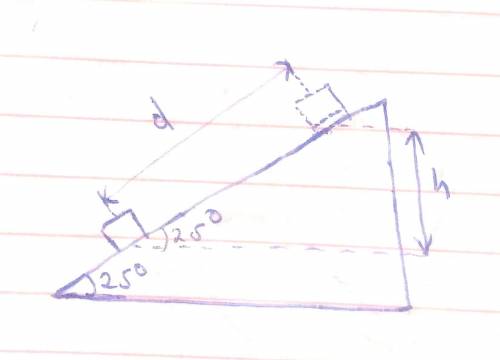
Physics, 19.03.2020 20:38 edwardordonez66
An ice cube of mass 50.0 g can slide without friction up and down a 25.0 degree slope. The ice cube is pressed against a spring at the bottom of the slope, compressing the spring 0.100 m The spring constant is 25.0 N/m When the ice cube is released, how far will it travel up the slope before reversing direction?
Notice that all the initial spring potential energy was transformed into gravitational potential energy. If you compressed the spring to a distance of 0.200 m, how far up the slope will an identical ice cube travel before reversing directions?

Answers: 2
Another question on Physics

Physics, 22.06.2019 05:50
There are two routes similar in terrain; however, one route has an incline of approximately 28 degrees, and you must decide on which route to take. what is the maximum road grade that your fully loaded ecv can climb?
Answers: 2

Physics, 22.06.2019 07:30
Tall pacific coast redwood trees can reach heights of about 100 m. if air drag is negligibly small, how fast is a sequola cone moving when it reaches the ground f it dropped from the top of a 100 m tree?
Answers: 1


Physics, 22.06.2019 12:50
Assume you measured the mass of the cart to be (500 ± 1) g and the mass of the additional mass you put on the cart to be (500 ± 1) g as well. since the scale you are using in the lab cannot measure objects heavier than 600g you will have to sum up individual pieces and propagate the error. so what would be the mass and the standard error of the cart and the mass
Answers: 3
You know the right answer?
An ice cube of mass 50.0 g can slide without friction up and down a 25.0 degree slope. The ice cube...
Questions



History, 13.11.2020 20:10


Chemistry, 13.11.2020 20:10

Mathematics, 13.11.2020 20:10







Mathematics, 13.11.2020 20:10

Social Studies, 13.11.2020 20:10

Chemistry, 13.11.2020 20:10



English, 13.11.2020 20:10

Mathematics, 13.11.2020 20:10

 , b)
, b) 








